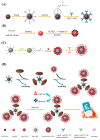Recent Progress on the Electrochemical Biosensing of Escherichia coli O157:H7: Material and Methods Overview
- PMID: 32443629
- PMCID: PMC7277213
- DOI: 10.3390/bios10050054
Recent Progress on the Electrochemical Biosensing of Escherichia coli O157:H7: Material and Methods Overview
Abstract
Escherichia coli O157:H7 (E. coli O157:H7) is a pathogenic strain of Escherichia coli which has issued as a public health threat because of fatal contamination of food and water. Therefore, accurate detection of pathogenic E. coli is important in environmental and food quality monitoring. In spite of their advantages and high acceptance, culture-based methods, enzyme-linked immunosorbent assays (ELISAs), polymerase chain reaction (PCR), flow cytometry, ATP bioluminescence, and solid-phase cytometry have various drawbacks, including being time-consuming, requiring trained technicians and/or specific equipment, and producing biological waste. Therefore, there is necessity for affordable, rapid, and simple approaches. Electrochemical biosensors have shown great promise for rapid food- and water-borne pathogen detection. Over the last decade, various attempts have been made to develop techniques for the rapid quantification of E. coli O157:H7. This review covers the importance of E. coli O157:H7 and recent progress (from 2015 to 2020) in the development of the sensitivity and selectivity of electrochemical sensors developed for E. coli O157:H7 using different nanomaterials, labels, and electrochemical transducers.
Keywords: E. coli O157:H7; biomedical analysis; biotechnology; electrochemical biosensors; environmental monitoring; portable biodevice.
Conflict of interest statement
The authors declare no conflict of interest.
Figures







Similar articles
-
Electrochemical biosensors for rapid detection of Escherichia coli O157:H7.Talanta. 2017 Jan 1;162:511-522. doi: 10.1016/j.talanta.2016.10.050. Epub 2016 Oct 12. Talanta. 2017. PMID: 27837864 Review.
-
Review: Trends in point-of-care diagnosis for Escherichia coli O157:H7 in food and water.Int J Food Microbiol. 2021 Jul 2;349:109233. doi: 10.1016/j.ijfoodmicro.2021.109233. Epub 2021 May 4. Int J Food Microbiol. 2021. PMID: 34022616 Review.
-
Electrochemical genosensor based on gold nanostars for the detection of Escherichia coli O157:H7 DNA.Anal Methods. 2022 Apr 21;14(16):1562-1570. doi: 10.1039/d2ay00056c. Anal Methods. 2022. PMID: 35357389
-
An electrochemical immunosensor for sensitive detection of Escherichia coli O157:H7 by using chitosan, MWCNT, polypyrrole with gold nanoparticles hybrid sensing platform.Food Chem. 2017 Aug 15;229:358-365. doi: 10.1016/j.foodchem.2017.02.083. Epub 2017 Feb 21. Food Chem. 2017. PMID: 28372186
-
Point-of-Care Diagnostic Devices for Detection of Escherichia coli O157:H7 Using Microfluidic Systems: A Focused Review.Biosensors (Basel). 2023 Jul 17;13(7):741. doi: 10.3390/bios13070741. Biosensors (Basel). 2023. PMID: 37504139 Free PMC article. Review.
Cited by
-
Microfluidic Sensor Based on Cell-Imprinted Polymer-Coated Microwires for Conductometric Detection of Bacteria in Water.Biosensors (Basel). 2023 Oct 20;13(10):943. doi: 10.3390/bios13100943. Biosensors (Basel). 2023. PMID: 37887136 Free PMC article.
-
Research progress on detection techniques for point-of-care testing of foodborne pathogens.Front Bioeng Biotechnol. 2022 Aug 8;10:958134. doi: 10.3389/fbioe.2022.958134. eCollection 2022. Front Bioeng Biotechnol. 2022. PMID: 36003541 Free PMC article. Review.
-
A Dual-Recognition Electrochemical Sensor Using Bacteria-Imprinted Polymer and Concanavalin A for Sensitive and Selective Detection of Escherichia coli O157:H7.Foods. 2025 Mar 21;14(7):1099. doi: 10.3390/foods14071099. Foods. 2025. PMID: 40238203 Free PMC article.
-
Electrochemical Impedance Spectroscopy-Based Microfluidic Biosensor Using Cell-Imprinted Polymers for Bacteria Detection.Biosensors (Basel). 2024 Sep 18;14(9):445. doi: 10.3390/bios14090445. Biosensors (Basel). 2024. PMID: 39329820 Free PMC article.
-
New PEPTIR-2.0 Peptide Designed for Use as Recognition Element in Electrochemical Biosensors with Improved Specificity towards E. coli O157:H7.Molecules. 2022 Apr 22;27(9):2704. doi: 10.3390/molecules27092704. Molecules. 2022. PMID: 35566054 Free PMC article.
References
-
- Tarditto L.V., Arévalo F.J., Zon M.A., Ovando H.G., Vettorazzi N.R., Fernández H. Electrochemical sensor for the determination of enterotoxigenic Escherichia coli in swine feces using glassy carbon electrodes modified with multi-walled carbon nanotubes. Microchem. J. 2016;127:220–225. doi: 10.1016/j.microc.2016.03.011. - DOI
-
- Banerjee T., Sulthana S., Shelby T., Heckert B., Jewell J., Woody K., Karimnia V., McAfee J., Santra S. Multiparametric magneto-fluorescent nanosensors for the ultrasensitive detection of Escherichia coli O157: H7. ACS Infect. Dis. 2016;2:667–673. doi: 10.1021/acsinfecdis.6b00108. - DOI - PMC - PubMed
-
- Kim S.U., Jo E.-J., Mun H., Noh Y., Kim M.-G. Ultrasensitive detection of Escherichia coli O157: H7 by immunomagnetic separation and selective filtration with nitroblue tetrazolium/5-bromo-4-chloro-3-indolyl phosphate signal amplification. J. Agric. Food Chem. 2018;66:4941–4947. doi: 10.1021/acs.jafc.8b00973. - DOI - PubMed
-
- Li T., Zhu F., Guo W., Gu H., Zhao J., Yan M., Liu S. Selective capture and rapid identification of E. coli O157: H7 by carbon nanotube multilayer biosensors and microfluidic chip-based LAMP. RSC Adv. 2017;7:30446–30452. doi: 10.1039/C7RA04583B. - DOI
-
- Chen R., Huang X., Li J., Shan S., Lai W., Xiong Y. A novel fluorescence immunoassay for the sensitive detection of Escherichia coli O157: H7 in milk based on catalase-mediated fluorescence quenching of CdTe quantum dots. Anal. Chim. Acta. 2016;947:50–57. doi: 10.1016/j.aca.2016.10.017. - DOI - PubMed
Publication types
MeSH terms
Grants and funding
LinkOut - more resources
Full Text Sources

